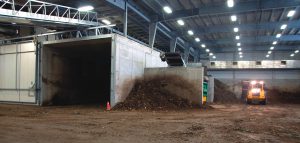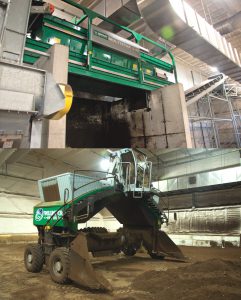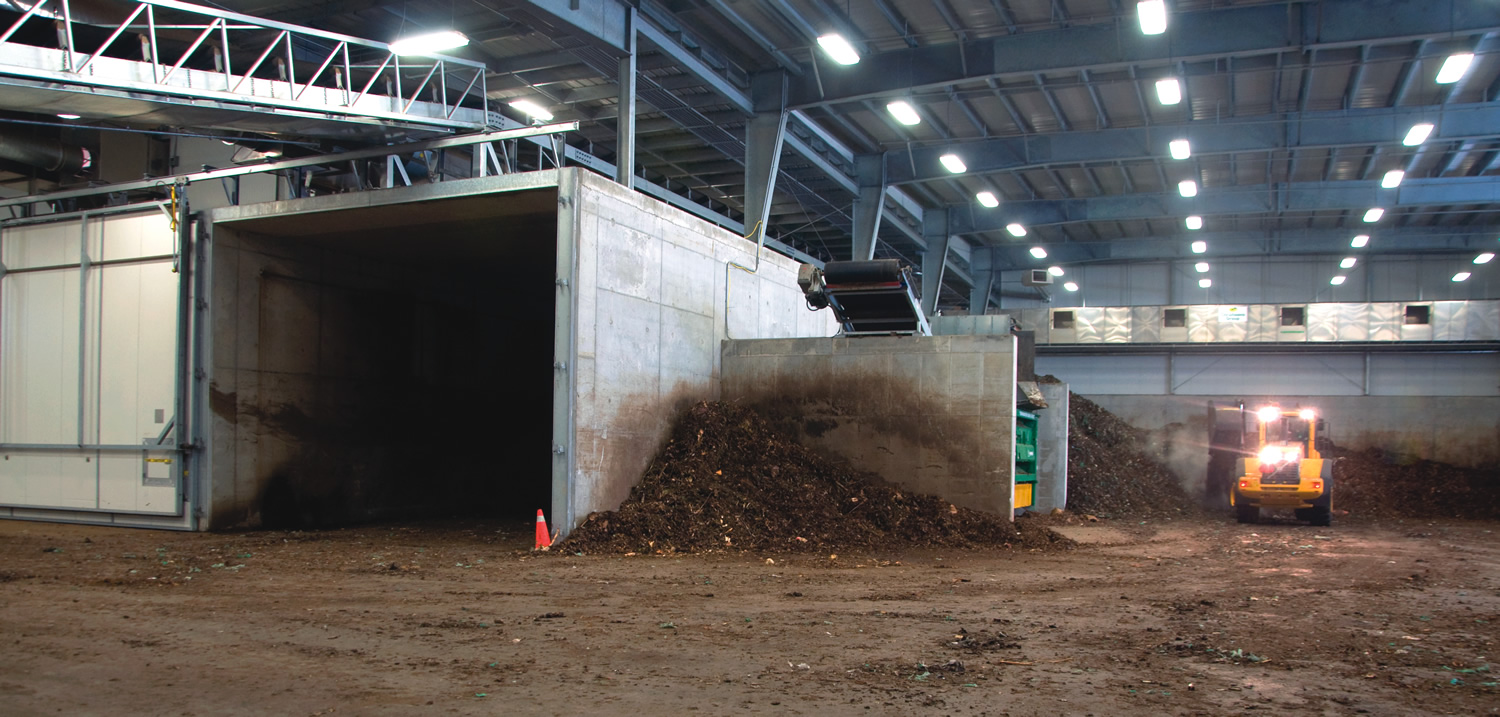New facility is designed to process 33,000 tons/year of source separated organics from residential curbside collection.
Peter Gorrie
BioCycle April 2012, Vol. 53, No. 4, p. 37

After unloading on the tipping floor, organics are shredded, mixed with amendment and loaded into one of four Phase One aerated composting tunnels.
The plant officially opened on September 27, 2011, and is built with the capacity to compost 33,000 tons/year of source separated organics (SSO) from 45,000 households in the city of 125,000 as well as the nearby Region of Waterloo (about 11,000 tons from Guelph and 22,000 tons from Waterloo region). During the commissioning phase of the facility, there were a couple of incidents relating to odor that were attributed to the facility. The city of Guelph ceased receipt of SSO until they were able to determine the cause. Shipments were halted last November while the plant’s designer and builder, Maple Reinders Inc., devised a plan for modifications. The OWPF recently started operating again at partial capacity. The modifications appear to be working, and, “full-scale operations … could resume by late spring,” said Janet Laird, Guelph’s executive director of planning and building, engineering and environment, in a recent statement.
While the new facility appears to be on the way to problem-free operation, the experience demonstrates that what seems a simple process is, in fact, very complex, says David Gordon, who oversees the contract with the plant’s operator for the city. Also complicating matters is a recent ruling by a provincial Environmental Review Tribunal concerning an unrelated composting facility in Ottawa that could lead to significant changes in the remainder of Guelph’s new collection plan.
Brief History
Until 1996, Guelph residents sorted wastes into dry recyclables, deposited in a blue box, and trash, which was landfilled. That year, the city began a two-stream system, with wet wastes on one side and all dry wastes, recyclable or not, on the other. The material was collected in one pass by trucks equipped with “wet” and “dry” compartments and taken to the new waste management facility, on a 25-acre site. Wet wastes were composted. Dry materials were sorted, with as much as possible being recovered for recycling.
While 98 percent of residents participated, little more than half the recyclable materials were captured. So, in 2001, the city switched to a three-stream system in which residents separated their wastes into wet and recyclable materials and garbage. The change dramatically improved the diversion rate but by then the composting facility was encountering difficulties. The buildings housing the tipping floor and composting channels were showing signs of corrosion from the moist, acidic atmosphere. By 2006, the problem was so severe that the buildings were deemed structurally unsound and the plant was shut down.
During its final three years of operation, the facility was the subject of 100 odor complaints. The provincial Ministry of the Environment also fined the city for violations of the operating license, mainly related to open-air screening and storage of compost.
After the plant was shut down, Guelph sent its organic wastes to an incinerator in Niagara Falls, New York, at a cost of about $77/ton. Those shipments ceased when the new plant opened. During the recent closing, the SSO have been trucked to a landfill in nearby St. Thomas, Ontario at a cost of $52/ton, plus hauling.
Fresh Start
The new composting plant sits on the same site as the old one. It’s operated under a five-year contract by Wellington Organix Inc., which is part of AIM Environmental Group, a company based in Stoney Creek, Ontario. Maple Reinders recently bought a controlling interest in AIM. At full capacity, up to 20 trucks a day will deliver SSO — about 11,000 tons annually from Guelph and 22,000 tons from Waterloo.
The city will pay AIM the equivalent of about $72/ton for processing waste in the plant, considerably more than the cost of landfilling, when the costs of amortization are included. Despite that cost premium, “it’s the right thing to do,” says Dean Wyman, Guelph’s general manager of solid waste resources, who says the city “is environmentally conscious,” and opinion surveys show strong support for waste diversion.
The organics facility is part of a waste management plan with what Wyman terms “fairly aggressive” targets — 55 percent diversion from landfill by the end of this year, 65 percent by end of 2016 and 70 percent by 2021 — along with generating, “less waste per capita than any comparable Canadian city.”
AIM will market the compost, mainly to local farmers, and keep the revenue from those sales. Guelph, as the facility’s owner, gets any income from credits for greenhouse gas reductions — not yet quantified — or other environmental attributes.
The plant was built after two open-house style meetings and two more with nearby residents, along with regular updates to city council and the neighbors. The City will have an improved complaints response system involving staff being on-call 24 hours a day. There is also a public liaison committee in place that local residents can participate in to monitor operations of the new facility. These items are to keep the local community engaged.
Reduction of odors, which have plagued other Ontario composting operators in recent years, was of paramount concern in the selection of the companies to design, build and operate the plant, Wyman says. The technical specifications for the facility that were contained in the RFP documents incorporated many items related to design and operational best management practices, and the evaluation team spent considerable time during the selection process analyzing the odor control features of the proposals received. Further effort was spent on modelling the odors before the contracts were finalized and signed.
Incorporating best management practices for design and operations was crucial, given the experiences with the previous plant and others in Ontario, says Scott Gamble of CH2M Hill, an international consulting company that worked with the city to draw up specifications for the project and assess the bidders. “It’s the reality of our industry that when you’ve had odor problems in the past, people are going to be leery about you trying to do it again.”
Facility Operations
The operation is entirely inside a building that’s kept under negative pressure to keep the air from escaping the building. Delivery trucks enter through high-speed roller-shutter doors equipped with air curtains to keep air from escaping.
Waterloo’s loads are routed through a transfer station, and arrive unbagged in rolloff trucks in loads of about 15 tons. Guelph delivers the collected SSO directly to the plant in the trucks that picked them up at curbside. For now, most of that material is in clear green plastic bags. Within days, organics sealed in the plastic bags start to undergo anaerobic decomposition, which can lead to problems at the processing plant. To minimize the chance of anaerobic conditions, the system is designed so that only a few hours elapse between pickup and processing, Wyman says. “It’s all about getting the material mixed and into the tunnels.”
After unloading on to the tipping floor, the organics — including the Guelph material currently in plastic bags — almost immediately are processed through a Komptech 5000 Terminator shredding machine. Then, a conveyor moves them to a pad where a front-end loader combines them with amendment, including wood chips, leaves and yard trimmings. Overs from finished compost screening are added in as well.
Loaders take the blended material into one of four Phase One aerated composting tunnels that are based on a design by the Christiaens Group. Each tunnel is 120 feet long, 26 feet wide and 20 feet high, and able to hold up to 660 tons of material. Retention time in phase one is two weeks; the volume of material drops by 40 percent as it decomposes. The process is then repeated in three Phase Two tunnels, identical to those in the previous stage, where material composts for five to seven days, with an additional 15 percent reduction in volume.

After about 21 days of composting in the tunnels, material is screened (top), with unders taken to a curing building where the compost is turned daily (above) for at least three weeks.
The curing building is actually part of the original plant says Gamble. The structural inspections conducted for Guelph in 2005 and 2006 revealed that the corrosion damage here wasn’t significant. The city therefore “recycled” the structure into the design of the new facility. However, to protect it from further damage and extend its lifespan, the walls and ceiling were coated with StayFlex, a spray-on system from Preferred Solutions Inc. “The composting industry has had good success with this product,” says Gamble. Fans and ductwork were installed in the tipping and tunnel areas to quickly remove potentially corrosive air.
Matured compost is analyzed for heavy metals and pathogens. If it passes, it’s ready for sale and use. The environment ministry has guidelines for compost quality and Guelph must produce “Class A.” If the compost fails the test, the facility operator can either send it to landfill or put it back through the tunnel system. So far, all compost produced at the new facility has been “Class A.”
Odor Management
The odor management system is intended to thoroughly clean the inside air before it’s emitted to the atmosphere. The Certificate of Approval (COA) issued by the Ontario Ministry of Environment (MOE) requires no more than one odor unit at “the nearest sensitive receptor”— in this case, the plant’s property line. Air from all parts of the plant is taken through a humidification chamber and acid scrubber. If there is a high level of ammonia in the air stream it is dosed with sulfuric acid to remove the ammonia before the air is treated via the biofilters. The process generates ammonium sulfide, which the city hopes to sell.
The Guelph facility has three biofilter cells installed by Biorem Inc. that use an inorganic filtering medium designed to remove odor molecules. The specification for the plant required that the biofilters be built with excess capacity, Gordon says. If one cell is taken offline for maintenance, the remaining two can still handle full-capacity operation. The air is then sent up the 160-foot stack and dispersed into the surrounding atmosphere. Modelling done by consulting engineers and the environment ministry estimate that it should have no impact on neighbors.
After the plant closure last fall, facility designers reviewed the air management and odor abatement systems. The investigation into the fugitive odors recommended several improvements. These first three are to ensure untreated air doesn’t escape from the plant:
• Air in the blower room, where fans push air to aerate the composting tunnels, had been vented directly outside, since it was considered “clean.” It’s now being put through the air-handling system.
• A carbon filter has been installed on the vent of a tank that holds waste ammonium sulfide, even though that unit isn’t expected to produce odors.
• Better seals were installed to prevent air leakage from a water holding tank.
The remaining changes are to upgrade the odor management system:
• The amount of wood chips/amendment being mixed with the SSO was increased to get a better C:N ratio and to minimize generation of ammonia. The goal is to keep it around 25:1.
• Airflow and moisture distribution were improved to make the ammonia scrubber more effective.
• A manual hand-held unit is replacing a device that was to automatically and continuously measure the ammonia going into the scrubber but didn’t function in the moist, acidic environment.
Collection Modifications
Guelph now requires that residents put organic wastes into clear green plastic bags, recyclables into blue bags and garbage destined for landfill into clear plastic. Organics and recyclables are collected weekly, and garbage every two weeks. While diapers and other sanitary products were previously allowed in the green bags, the COA for the new plant issued by the MOE bans them, because it believes these items have a negative impact on the composting process and increase the chance of odor generation. As a result, they now must go into the garbage stream.
The Certificate also forbids putting organic wastes into plastic bags. Instead, they’re to be placed, unwrapped or in paper, in a new type of cart that the city hasn’t yet selected. However, the COA allows Guelph three years to phase in the introduction of carts. In the meantime, the city must decide whether to appeal MOE’s ban on both the bag and the diapers.
The ministry imposed the same bans on diapers and plastic bags on a composting plant operated by Orgaworld Canada Ltd., in Ottawa. Orgaworld appealed the restrictions to Ontario’s Environmental Review Tribunal. In November the tribunal ruled in favor of the company. The ministry didn’t appeal, but says it doesn’t view the ruling as a precedent. “The decision does not hinder the ministry’s ability to impose site-specific approval conditions on organics facilities in the future as needed,” a spokesperson says. “And irrespective of this ruling, it’s within a proponent’s right to appeal ministry approval conditions and the (tribunal) will make decisions on these appeals based on the merits of individual cases.”
That means it’s up to Guelph to decide whether to seek changes in its COA. The current conditions are unpopular with some residents, Gordon notes. They dislike having diapers and sanitary products sit for up to two weeks in clear bags awaiting the garbage collection. And plastic bags reduce the “yuck” factor associated with organic wastes. But the city will wait until the composting plant is operating successfully at full capacity before considering how to proceed, he says, noting that the facility can cope with diapers and sanitary products. It can also handle wastes in plastic bags, as is being demonstrated now, he adds. “There are no operational issues. It’s more what works best for the residents.”
In the new curbside pick-up procedure, collectors will no longer manually put bags of waste into trucks. Instead, the city will provide each household with three carts — green for organics, blue for recyclables and black for trash — that will be picked up, emptied and returned to the curb by a robotic arm while the driver remains inside the cab. Although the system will work best where residents can leave the carts on their driveway, the arm can reach over cars to grab carts in neighborhoods with on-street parking. In particularly congested areas, residents have to use a central collection point.
Each new truck will cost nearly $25,000 more than a conventional model. But the change is expected to reduce the number required from 19 to 15 and cut the city’s operations budget by up to $400,000 a year.
Under the new system, the city will end separate collections of leaves and yard trimmings. Those materials must go, instead, into the green cart. If there’s too much for the cart, households can use a backyard composter or bring them, with no fee, to the city’s “Waste Resource Innovation Centre.”
Peter Gorrie is a Contributing Editor to BioCycle.










